How I Shifted a Small Business Into Rapid Growth
Business transformation is never easy. It requires glaring at your past and believing in a future that will involve resources, money and time. Having an effective strategy to move out of the beginning stages of your business and from small to growing is your key to opening a door of possibilities.
Over the period of 2 years, this business went from failing to spiking in growth. When I began working with this client, they were suffering from the Covid breakdown. Before this time, they had a small business of 5 people that supported base line assistance work and public events. Covid caused them to lose all their clients and move to $0.
At that point, the CEO and VP decided to invest forward instead of waiting for a change of tide. They switched their strategy from locality based to online, dreaming of a future that could be international by switching to virtual classes and events while offering training that wasn’t subject to location.
The change they made was drastic and by the time I began working with them, they admittedly noted that their processes and systems were messy, broken, and flailing in several areas. Nothing was functional for the internal team as well as within the technology system that was used.
This led to massive opportunities to restructure and identify best practices to shift the focus of the business.
Here’s how I did it.
Getting the Holistic Perspective
The first step that any strategist should take is to breadcrumb back to the beginning. If we aren’t asking what’s been set up, what’s working, and what’s not, then there isn’t anything to leverage. Amazingly, this is where many businesses lose site of what they should be doing and instead grapple with emergency reactions that aren’t necessary.
The holistic perspective in this instance wasn’t just looking at specific sides of the business. It is to look at everything.
1. What tech stack where they using?
2. How was performance?
3. How did the team relate to the tech stack?
4. What processes were or were not in place?
5. What angles where a part of the interactions from customers that were important to note?
It’s important to let a strategist in and identify what’s going on with your business. Any blind spots they have can domino effect the entire business. That leads to broken processes and the inability to grow.
One thing worth mentioning here… in this instance, and in several instances, there was resistance to letting some of the processes unite. This is something that I see quite often. One department, or even the CEO, wanted to maintain doing something the same way. Mostly because it was done initially as a reaction and worked and now there was a fear, or maybe even pride, around change. This is the most dangerous way to respond to strategy.
Why?
In 2 years, when a business grows to 500+ employees and is continuing to expand, that process will be the same. And the others won’t be. That means you will have to hire people to maintain that process because it’s not united with everything else you’re doing. And, more importantly, you can’t fix it as easily as you can as a small business. There’s more collateral, assets, and the systems that are breathing and working for you everyday can no longer go through change or shifts. You’re dealing with a numbers game that breaks at one side or another.
The word of advice – don’t follow the philosophy of use it until it breaks. Instead, set the strategy up correctly the first time.
Digging Into Sales
The initial reason I came on to help this client was because of their sales process. It was highly manual and massively broken. Sales responses were manual, and like what happens most of the time, leads would fall through the cracks. Even though HubSpot was being used, there were about 5 different pipelines and several looping workflows and everyone in sales was using it differently. There were also reminders and emails firing off, but not necessarily at the right time.
The first project that was taken into hand was to fix a broken system. We streamlined the pipeline against automated emails and identified when each individual was coming in and what they were doing. Each part of this pipeline highlights the main initiatives the sales team needed to take. A combination of sales high-level user behaviors in combination with the leads and expectations that they had.
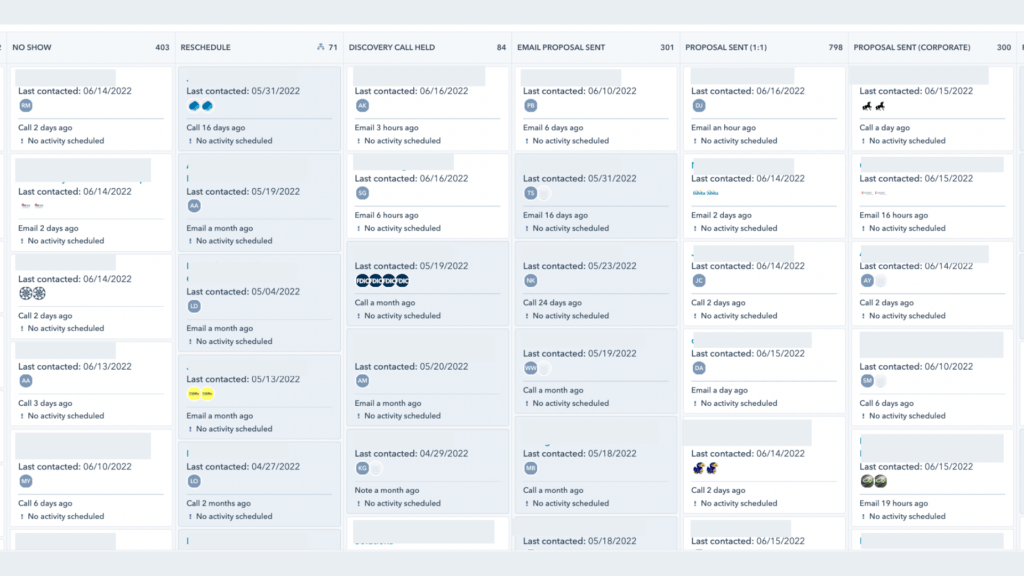
The pipeline upgrade was just the start. We then took the leads and segmented them by the type of help they needed (e.g. individual coaching vs. corporate workshops). These led to sales team members who were responsible for different types of sales and scripts depending on what someone needed.
One of the most powerful and lucrative things I’ve noticed with sales is automation. It can manage a board much easier without it infiltrating the system. We set up a combination of reminders for 3 day and day of meetings to lower drop out rates. This was combined with text messaging within the system. We also added in different language and expectations based on the type of sale the individual wanted.
We also set up automations for no shows, reschedules, and cancellations, allowing an individual several chances to come back for a meeting. This significantly reduced dropped meetings by over 60%, without having to touch a dial. At the same time, the reminders for the meeting had strong engagement of an average of 40%, with it becoming an effective method to get to a close.

The next changing point within the sales flow was to stop the manual responses after a call. Each section within the pipeline led into an automation, unless it was tagged that it needed a manual follow up. These went into a separate bucket, highlighting that there were special or custom needs.
Once the Discovery Call was held, data was entered for the lead and led to sending a proposal. This went into a series of follow-ups that automatically let someone know they should carry through to signing a proposal and to start services or to hop on another call.
The continuous email reminders supported the sales process, causing the sales cycle to take less time and resulting in an increase in sales. Because there was continuity in follow-ups that satisfied the response needs of over 90% of those on a sales call, it significantly increased the ROI within the company. For the first time in 10 years, the company experienced a significant quarterly profit, whereas past years always led to the company being in the black.
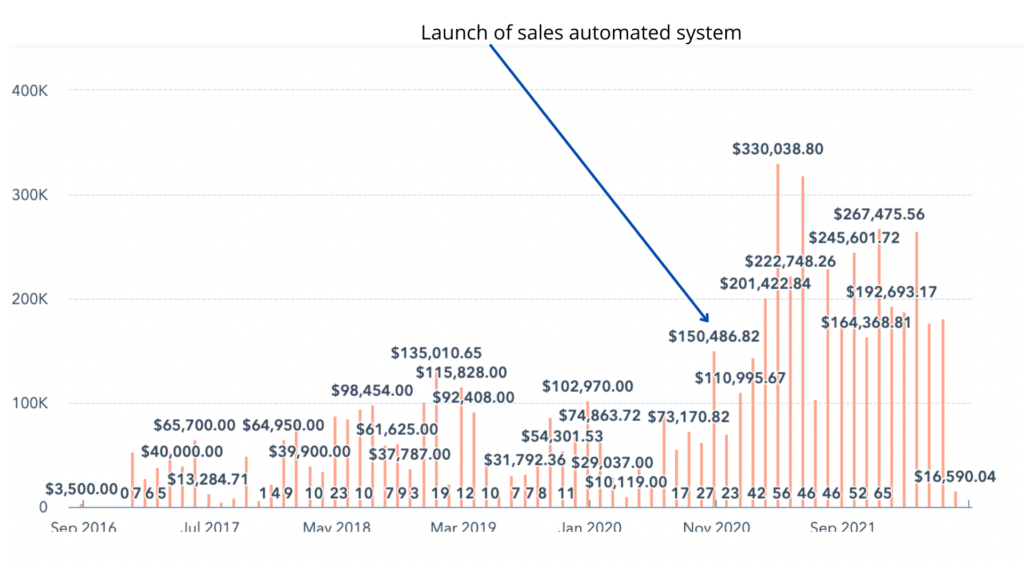
Pushing Into the Lifecycle
Sales changes and processes were the beginning of a series of automated processes that were designed to support a small and growing team and to change the way that marketing was impacted. The lifecycle streams of communication were the next series of systems that were set up. This supported an ever growing newsletter while reworking every other area of lifecycle. While there were some systems in place, most were broken or lacking in proper communication while others were manually sending blasts without recognizing how automation could be used.
A complete lifecycle program was built strategically and developed over a period of 6 months, allowing the team to lean on automations in order to warm leads and nurture clients.
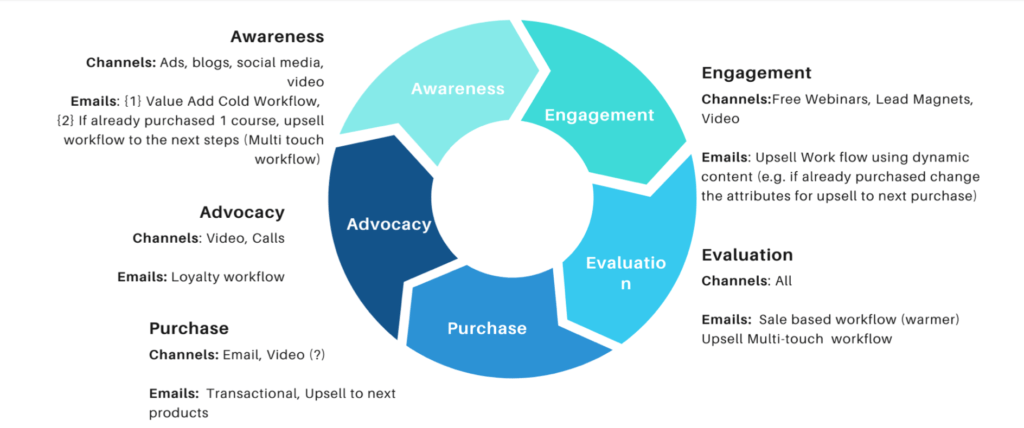
For Engagements and Leads
Each area of lifecycle deserves its own, highlighted area of how the strategy was able to influence the overall brand building of the company. This became integral because of the small size of the team and the need for them to have automation to support what they were doing.
Leads were divided into segments, highlighted by the ads that they came from (e.g. keyword focuses led to visiting an internal page). The internal pages had lead magnets that were specific to the service one was looking for, allowing someone to get catered to while receiving free information based on their initial search. This resulted in a series of follow-ups that either focused on getting them into a sales call for evaluation or into a purchase of one of the smaller items. The click throughs in the chart below show individuals who either set up a call as a result or purchased on of the courses available.
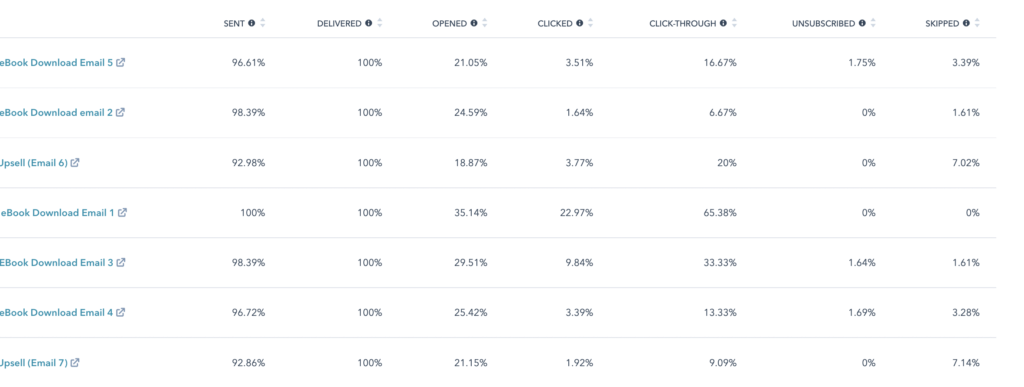
The number to look at is the click through rate. In most instances, a click through ranges from 2-5%, especially when it’s a cold lead that comes in with a lead magnet from a keyword. In these instances, the email click through rate ranged from 15-20%, showcasing the interest as well as the impact of one of the lead magnets. This is attributed to the deep segmentation as well as the strategic approach of the workflow that was used to warm and nurture clients.
Purchases and Promos
In most instances, lifecycle for purchases is looked at as transactional. However, this particular client required specific additions that increased engagement, especially for the lower purchased items. There are two proponents to the purchase emails that were put in place, highlighting the sale of online and virtual events offered by the company as well as specialized approaches that were used.
When first starting to work with this client, they manually sent reminders for events 7 days, 3 days and 1 day before a live online class. To switch this, we moved the client online. We installed WooCommerce and took them out of a stand alone third party that didn’t allow the ability to save leads. We also connected this to a complete tech stack, allowing users to go to Thinkific if they had an on-demand course, and giving them restricted access to resources through WooCommerce or their workshop leader.
To work through this, a series of workflows were built in HubSpot, all which focused on a combination of transactional and nurturing items for the classes. Two were transactional, offering official receipts and confirmation of purchase. One was transactional for a link to get into the class plus to get resources. Others served as reminders with those who were attending the class.
The workflows were segmented by date, time, and class. Separate workflows were built for complimentary classes that were sometimes offered as well as for bundles, which included purchase upsells of up to 6 classes. Sample workflows were as follows:
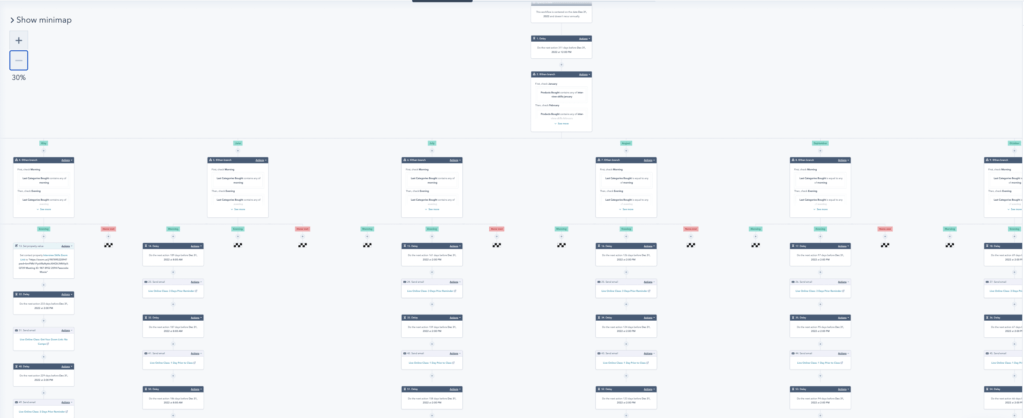
With this purchase nurture series in place, there was the ability to change marketing approach. Before this point, scaling was impossible. Most employees were inundated with sending out individual emails and the number of classes offered online were limited to 8 in 1 month.
With the technology in place, there was a reduction in the amount of manual work that was required to 1% based on troubleshooting. The courses went from being offered 1 x per day to being offered 2x per day.
More important, strategies could now be put in place to upsell and crossell customers. By having all data live in 1 system, instead of through a manual approach, interests and past classes could be seen. This led to personalized and targeted messaging to assist with those that were interested in the products and services.
The opportunity led to promos that started to take place through Facebook Ads and other channels, all which were associated with filling classes and expanding the opportunities.
The first test which took place with this was a Cyber Monday deal, allowing users to buy a course for a percentage off. This is continuing to be followed with quarterly deals and promotions, all which support nurturing and upselling leads.
The Cyber Monday promotion and follow through is a supportive example of how this can grow. The size of each class doubled for the following three months, some which sold out. The leads in the system closed for the first time and others within the system dove at the introductory classes to the company. More important, it instigated a new formula that could be used with selling and expanding the classes while developing a nurture based sequence for purchases.
Loyalty
Loyalty is one of the most important aspects of lifecycle, leading to referrals, upsells, and the ability to build a strong brand identity. The loyalty with the client was taken with a Google Form, asking clients to click a link and fill out a form. This was often not compiled, and work had to be done manually. More important, a database was missing with feedback, not allowing for more responsiveness and nurturing with those who were already clients. Many of the clients dropped after a short coaching session, while others did not receive attention or care when not being satisfied with their courses.
To change this process, all information was added into a central database. A text response was added in for those to enter an immediate survey on their phone during a workshop. This was combined with a workflow that highlighted 2 new concepts. The first was a follow-up for those that didn’t respond to the questionnaire. The second was highlighting how someone responded. If they had higher scores, they went into a loyalty tier for referrals. If not, they were either considered “neutral” or received a follow-up to see how they could improve or help the potential client.
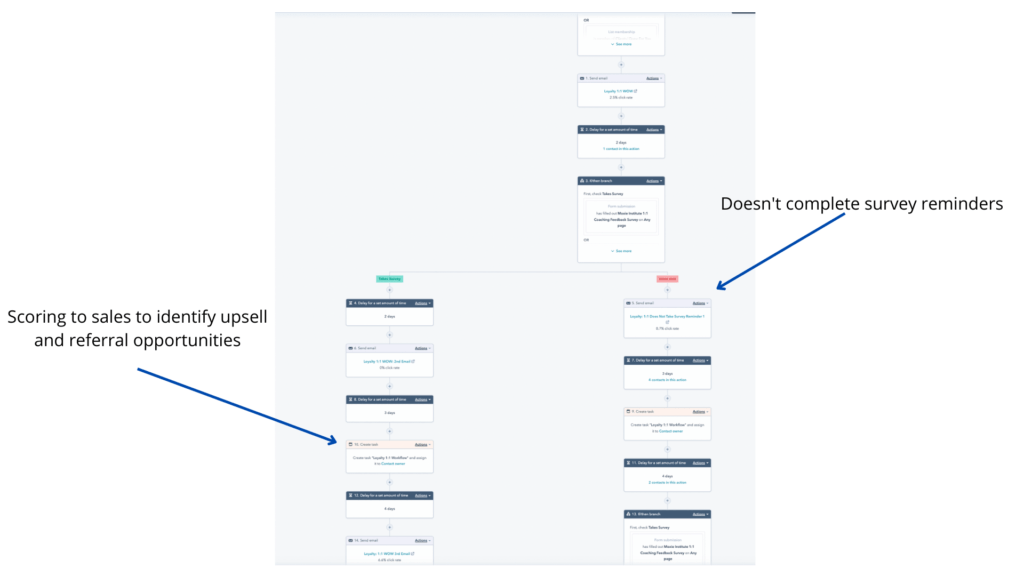
This initial segmentation increased the number of clients who bought more than once while identifying any pain points that were within the company. More importantly, it created a continuous movement toward better services and more loyalty to those using the services. The result was that, in a few months, there was a different brand value because of the care of their clients.
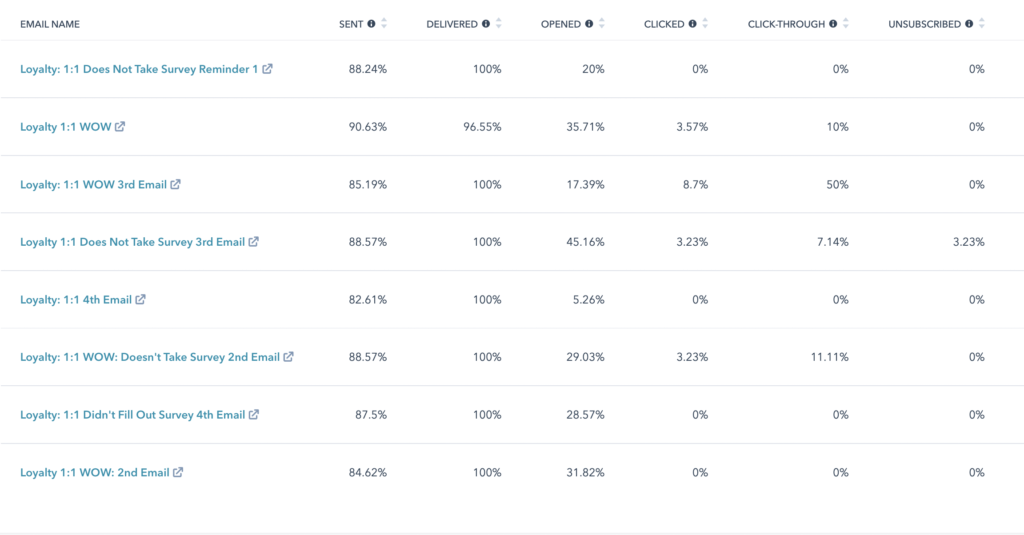
As can be seen from these statistics, there is a higher ratio of those who didn’t fill out the survey, ranging from 28 – 45% to re-engage with the client. For those that did take the survey, upsells, as well as extra bonuses, were offered. While some had lower open and clicks, examples like the 3rd email at 50% click-through show the engagement of the groups entering these workflows as well as how it is able to create a stronger reputation for the company and brand.
Impacting Processes and Systems
Team processes and systems were one of the areas where there was improvement, specifically with teams that had specific jobs or daily tasks. Finding ways to automate some of these tasks, set up reminders, and develop more efficiency was essential.
There were two approaches which were used to decrease the impact of those that were working within the system. The first was to create sources of truth that teams could rely on in order to maintain their jobs and receive proper information. The second was a combination of playbooks and SOPs to manage the systems so it remained streamlined.
The sources of truth that were created led to a centralized data system through the ESP that could be used to identify customers, interactions, and what was needed to keep them supported. This included highlighting and maintaining data in one central space as well as identifying how the team should use and work with data. A top-down initiative took place, in which the team had all user behaviors and information in one space, followed by the ability to group, segment and work with individuals from that central location.
The second process and system which was put into place was from the intertwining of systems into a fluid approach. Instead of independent technologies by department, all were placed into a transparent, central area. To follow this, playbooks were created, highlighting how the systems should be used to make the most impact, such as with the sample below:
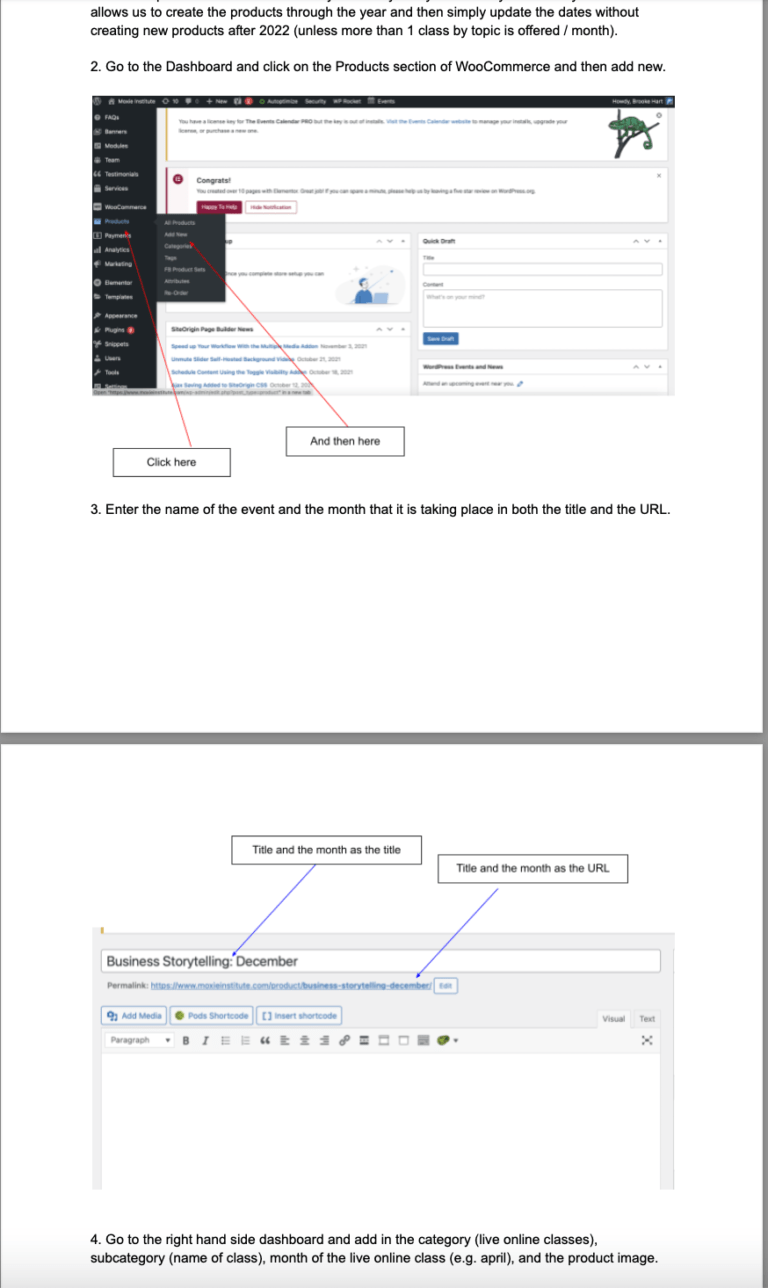
A total of 3 playbooks, all which were an average of 30+ pages, were developed for each team member to have a reference and resource to use the same systems. This was followed by training and follow-up to move team members from individual processes to those that were shared within the team.
SOPs were also created for the maintenance of systems as well as for the maintenance of strategies that were created. This helped to stay ahead of troubleshooting and assisted with maintaining the data and systems which were used. By doing this, it allowed users to stay ahead of troubleshooting and errors while dismissing potential issues which could arise.
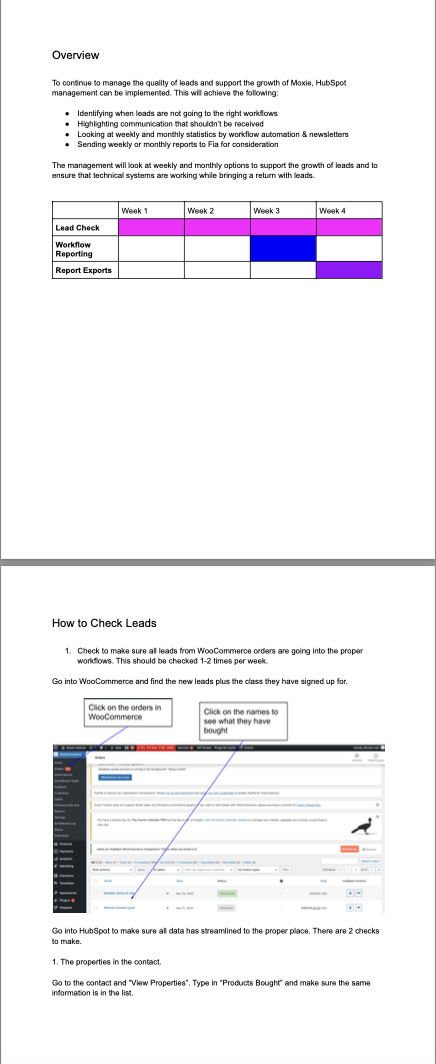
Changing the Face of SEO
When beginning with the company, there was a pain point in relationship to SEO and paid ads. Paid ads were leaned on heavily and often didn’t lead to best results. However, the website health as well as the optimization of the site blocked growth with organic search.
When beginning, the health of the SEO was below 50%, with massive numbers of technical issues that continued to block Google and other search engines from effectively reading the website. Before beginning to work with SEO, efforts were made to change the health of the site, removing all technical issues on the site. After completion, the graphics have remained at 98%, creating stability with the building and read out of the site.

The second phase of SEO was to focus on internal optimization. A system was created to change the way in which internal blogs and pages were optimized. There was currently no optimization on the site and no focus keywords that were used. Topics, specifically with blogs, were often scattered and didn’t take the several types of content into account. To manage the mass number of blogs, a cluster keyword map was created, combined with a process used between the writer and technical assistant for continuous progress.
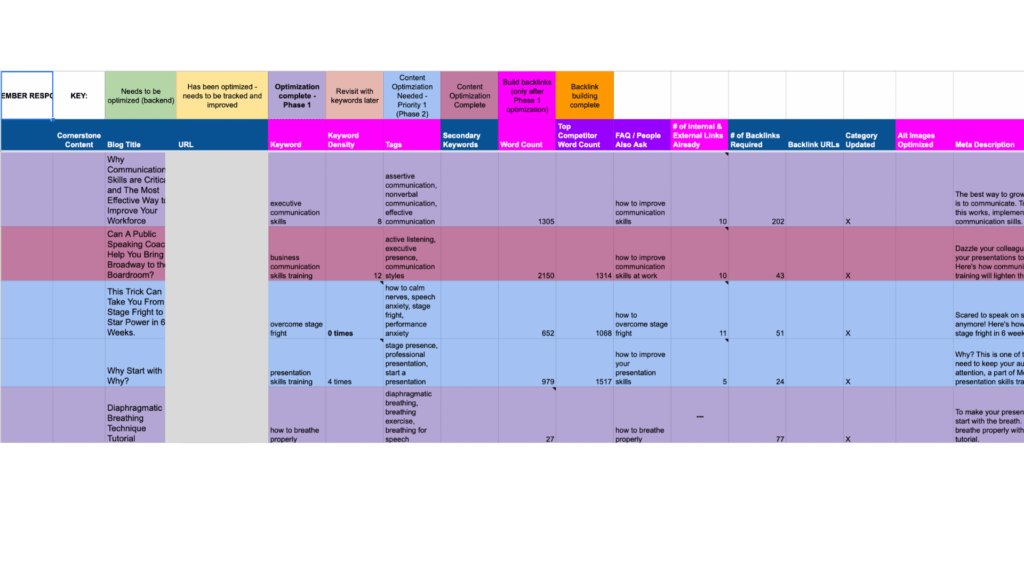
The third phase used was to work with a link-building agency that used our strategy, built internally, and to target the keywords determined for pages and internal optimization, using these to begin to rank at higher levels. This was combined with removing the current link-building company, which was not providing continuous results for those that were a part of the link building process.
After three months, there was a significant increase in the traffic and referring domains, resulting in organic traffic that had not been seen in the past.
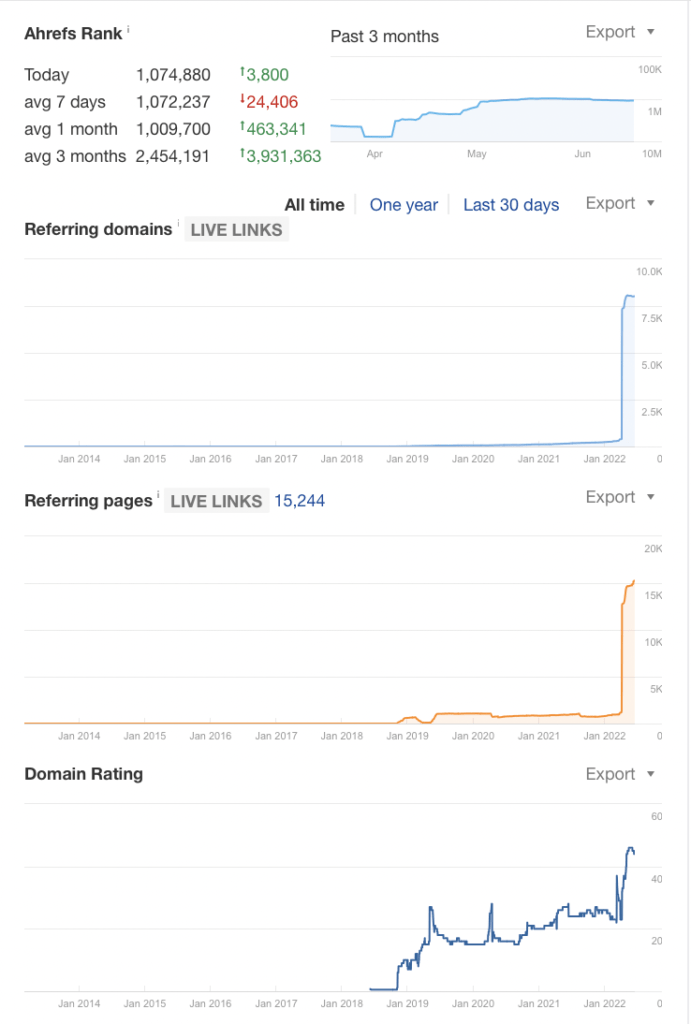
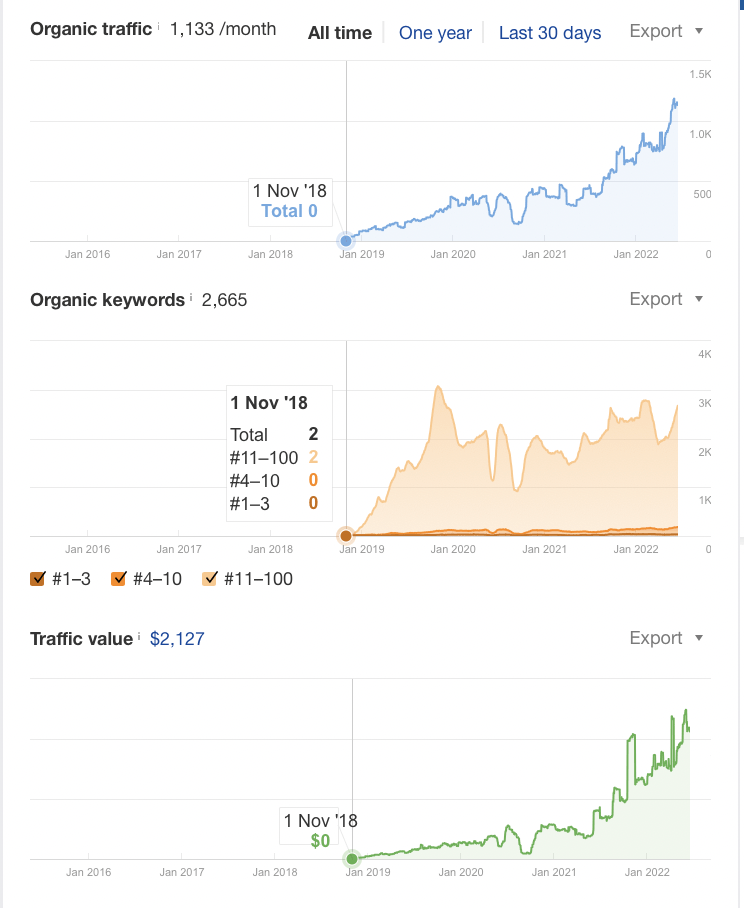
The Social Media Reset
Social media was one of the weakest points of the company, most of the time not being used. The social media specialist focused on 2 weekly posts, most which were loosely related to the company, if at all. The result was 300 people average on the different channels and little to no movement with channels that could lead to maximum results and clout for the company.
To shift this, a strategy was created and combined two aspects. The first was best practices for social media, such as how often postings should take place, what type of postings should be available and what the responsibilities were for those that were posting. Branding was focused on, building out templates that could be used for each of the channels was highlighted, and milestones were set to reach between quarters that were required to be followed. This forced responsibility from the current social media manager while focusing on growth within the system. The sample below shows how these milestones were laid out:
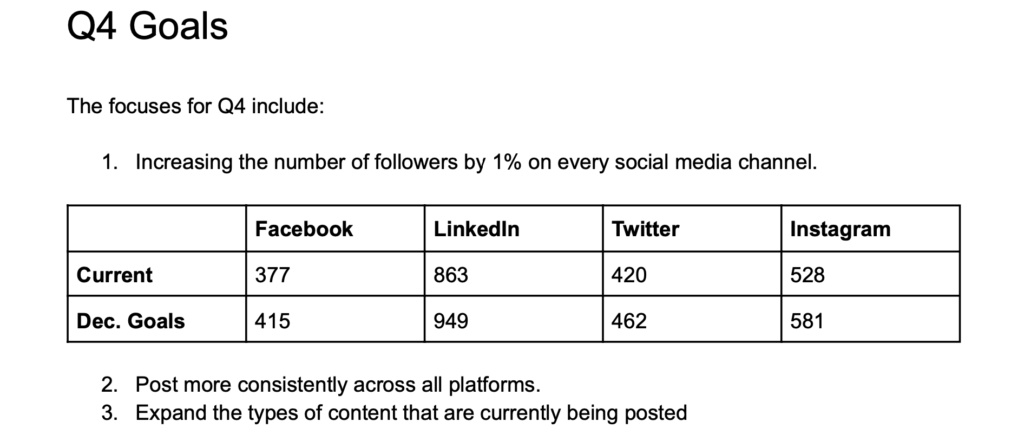
The strategy set in place included:
- Current internal analysis
- Competitive Analysis
- Types of Posts
- How to Build Shares, Likes, Comments
- Focusing on Brand Differentiation
- SWOT
- Content Calendar
- Connecting to Influencers
- Posting Styles
By expanding out the social media, the company was able to reset their social media and begin meeting the 1% growth per quarter through organic and continuous interactivity.
Chipping Into Client Relationships and Building Into Systems
One of the largest pain points of the company was a missing system for clients who were taking workshops, many which included one stakeholder and hundreds of participants. All work was done with manual emails that were sent, all which included several images and links within emails and which didn’t have follow-up. This led to human error, deep firewalls within the system and the inability for participants to receive information.
The feedback that was continuously received from those taking workshops was that they didn’t feel like they received the proper information or support before a workshop. As a result, the company would provide complimentary classes and would sometimes have to redo courses. It would also lead to poor ratings and the belief that the company was unprofessional and inefficient.
There were several areas where this fell through, some which were based on the operational management and the second with the lack of technical systems. To start changing this, there was an understanding that communication needed to alter, leading to several ways to nurture those that were preparing for a workshop. Users were often unable to receive resources from firewalls, spam and blocks within their office. This was combined with a lack of support from the team to ensure that they received information.
To change this, a communication strategy was suggested to alter the outcome of the workshop issues. This was combined with a processing system for sending out as a checklist, troubleshooting, and follow-up alternatives.

The second aspect of this was to develop a resource library, given to stakeholders at the beginning of their contract and making them liable for signing in and sharing with their team receiving pre-work. This was developed through the website, allowing the centralized system to be maintained while tracking who was signing in and who wasn’t before a workshop.
By developing a central area and tracking who was receiving resources, it allowed those who were providing support to track and target dynamics within various teams and to assist with altering the course of those that were involved with preparing for training.
The initiative was combined with the loyalty workflows, specifically by identifying those who continued to have similar issues with preparing and joining workshops, using this as a measurement until the system began to alter each experience.
Training, Training, and Training
A pain point that the team often had was the technical lack of understanding. While all processes were created, team members would often continue to use the tools in the same way or would break the processes because of a lack of understanding.
The playbooks and SOPs that were in place continued to be referred to by those that were using the systems. There were also training overviews that took place, specifically to initiate understanding within the team and to support the transfer from manual processes to an integrated system of working within the technology that was developed.
Results from Strategy First
The end of the engagement with the client led to an acknowledgment that there was a complete, technical system in place, as well as sustainable strategies that could continue to operate and build the company. Even without new growth or understanding, the company had the capacity to experience positive results within each area that was built for this system.
It is expected that, as the team grows, the systems will continue to reproduce and bring results to the team. Without any development of new systems, the processes and technology put into place will result in supportive and lucrative opportunities. The approach of strategy first, followed by calculated and significant implementation, showcases that the approaches used can build a sophisticated technical system that supports business.
